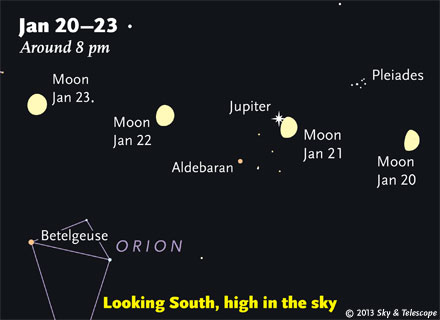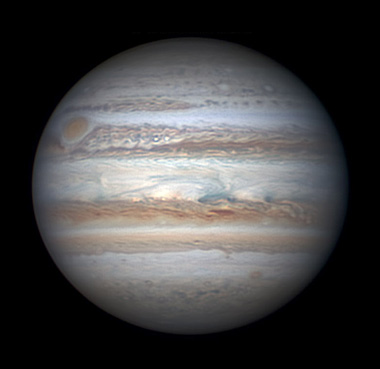Friday, January 18
Saturday, January 19
Sunday, January 20

The waxing gibbous Moon highlights an interesting section of the winter sky. (The Moon symbols are positioned for the middle of North America. They are drawn three times the Moon's actual apparent size.)
Sky & Telescope diagram
.
Monday, January 21
Although they look close together, the Moon is only 1.3 light-seconds distant from Earth, while Jupiter is 1,700 times farther away at a distance of 37 light-minutes. See our article Jupiter Dances with the Moon.
Tuesday, January 22
Look below the Moon for Orion, and far below Orion for brilliant Sirius.
Wednesday, January 23
Thursday, January 24
Friday, January 25
Sirius is the brightest star in the night sky — and are you far enough south to see the second brightest, Canopus? In one of the many interesting coincidences that devoted skywatchers know about, Canopus lies almost due south of Sirius: by 36°. That's far enough south that it never appears above your horizon unless you're below latitude 37° N (southern Virginia, southern Missouri, central California). And there, you'll need a flat south horizon. Canopus transits the sky's north-south meridian just 21 minutes before Sirius does.
When to look? Canopus is at its highest point when Beta Canis Majoris — Mirzim, the star a few finger-widths to the right of Sirius — is at its highest point crossing the meridian. Look straight down from Mirzim then.
Saturday, January 26
Want to become a better amateur astronomer? Learn your way around the constellations. They're the key to locating everything fainter and deeper to hunt with binoculars or a telescope.
For an easy-to-use constellation guide covering the whole evening sky, use the big monthly map in the center of each issue of Sky & Telescope, the essential guide to astronomy. Or download our free Getting Started in Astronomy booklet (which only has bimonthly maps).

The Pocket Sky Atlas plots 30,796 stars to magnitude 7.6 — which may sound like a lot, but that's less than one star in an entire telescopic field of view, on average. By comparison, Sky Atlas 2000.0 plots 81,312 stars to magnitude 8.5, typically one or two stars per telescopic field. Both atlases include many hundreds of deep-sky targets — galaxies, star clusters, and nebulae — to hunt among the stars.
Sky & Telescope
Once you get a telescope, to put it to good use you'll need a detailed, large-scale sky atlas (set of charts). The standards are the little Pocket Sky Atlas, which shows stars to magnitude 7.6; the larger and deeper Sky Atlas 2000.0 (stars to magnitude 8.5); and the even larger Uranometria 2000.0 (stars to magnitude 9.75). And read how to use sky charts with a telescope effectively.
You'll also want a good deep-sky guidebook, such as Sue French's Deep-Sky Wonders collection (which includes its own charts), Sky Atlas 2000.0 Companion by Strong and Sinnott, the bigger Night Sky Observer's Guide by Kepple and Sanner, or the beloved if dated Burnham's Celestial Handbook.
Can a computerized telescope replace charts? Not for beginners, I don't think, and certainly not on mounts and tripods that are less than top-quality mechanically (able to point with better than 0.2° repeatability). As Terence Dickinson and Alan Dyer say in their invaluable Backyard Astronomer's Guide, "A full appreciation of the universe cannot come without developing the skills to find things in the sky and understanding how the sky works. This knowledge comes only by spending time under the stars with star maps in hand."
This Week's Planet Roundup
Mercury is hidden in the glare of the Sun.
Venus (magnitude –3.9) is just above the southeast horizon about 30 minutes before your local sunrise. It's lower each morning. How much longer can you keep it in view?
Mars (magnitude +1.2) still glimmers very low in the west-southwest in the fading glow of sunset. Don't confuse it with Fomalhaut far to its left. (On January 24th Mars is at perihelion, its closest to the Sun in its orbit.)

The white turbulence following Jupiter's Great Red Spot, and unusual amounts of activity in the Equatorial Zone, are evident in this exquisite image taken on January 1st by Christopher Go in the Philippines. South is up.
Jupiter (magnitude –2.6, in Taurus) is the first "star" to come out high in the southeast after sundown. It dominates the high south after dinnertime, with orange Aldebaran lower left of it and the Pleiades to its upper right. In a telescope, Jupiter is still about 45 arcseconds wide. See our article "Observing Dynamic Jupiter" in the January Sky & Telescope, page 52 — including all of Jupiter's satellite events for January.
Saturn (magnitude +0.6, in Libra) rises in the east-southeast around 1 a.m. local time. By the beginning of dawn it's fairly high in the south — more or less between Spica, far to its right or upper right, and Antares farther to Saturn's lower left.
Uranus (magnitude 5.8, in Pisces) is still in view in the southwest right after dark. Finder chart.
Neptune (magnitude 8.0, in Aquarius) is disappearing into the sunset.
All descriptions that relate to your horizon — including the words up, down, right, and left — are written for the world's mid-northern latitudes. Descriptions that also depend on longitude (mainly Moon positions) are for North America. Eastern Standard Time (EST) equals Universal Time (also known as UT, UTC, or GMT) minus 5 hours.
Like This Week's Sky at a Glance? Watch our SkyWeek TV short. It's also playing on PBS!
To be sure to get the current Sky at a Glance, bookmark this URL:
http://SkyandTelescope.com/observing/ataglance?1=1
If pictures fail to load, refresh the page. If they still fail to load, change the 1 at the end of the URL to any other character and try again.
 0
0
Comments
You must be logged in to post a comment.